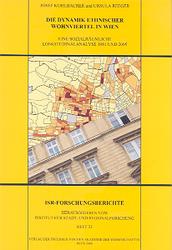

Aus dem Vorwort:
Wien ist wie viele andere westeuropäische Metropolen bereits seit den frühen 1960er Jahren zum Zielgebiet der Arbeitsmigration von „Gastarbeitern“ vom Balkan geworden. Die früheren „Gastarbeiter“ aus dem ehemaligen Vielvölkerstaat Jugoslawien stellen somit nicht nur eine der „ältesten“, sondern nach wie vor auch die zahlenmäßig bedeutendste Gruppe von Zuwanderern in Wien dar. Innerhalb der Metropolen findet eine ungleiche räumliche Verteilung der Wohngebiete auch dieser Zuwanderergruppe statt. Ethnische Segregation ist ein sozialräumliches Phänomen, welches in allen Großstädten auftritt. Die Exjugoslawen gehören zum Teil der unterschichtenden Komponente der Arbeitsmigration an, die sich nach wie vor besonders auf Wohngebiete mit älterem Baubestand und niedrigem Wohnstandard konzentriert.
…
From the Introduction:
Like many other West European metropolises, since the early 1960s Vienna has been a target for the migration of "guest workers" from the Balkan. "Guest workers" from the former multi-national Yugoslavia are not only the "oldest", but if based on numbers, also the most important group of immigrants in Vienna. The neighbourhoods of this group of immigrants are also unequally distributed throughout the metropolis. Ethnic segregation is a social-spatial phenomenon that occurs in all large cities. The population from former Yugoslavia belongs to one of the lowest classes of the worker migration, and it is still concentrated above all in neighbourhoods with older buildings and low living standards.
2006,
978-3-7001-3813-6
978-3-7001-7684-8
113 Seiten,
24x16,5cm, broschiert